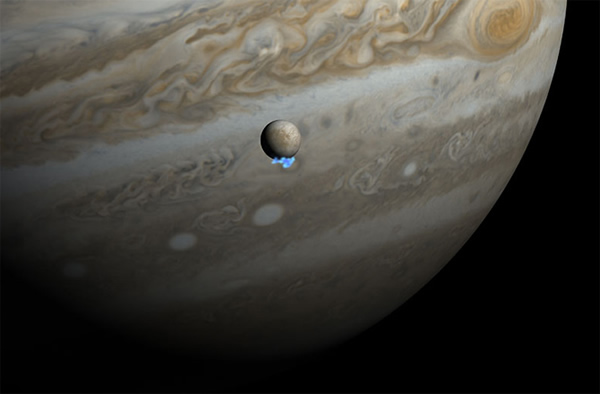Could Europa Discovery Spur Life-Hunting Mission?
Based on observations by the hubble Space Telescope, this artist's impresion shows the water-laced plumes hanging over Europa, with Jupiter as the backdrop.
As we celebrate China’s successful Chang’e 3 landing on the moon, the world’s media is abuzz with images of rocky, dusty alien landscapes once more. Granted, the images are notable in that we haven’t seen new photographs from the lunar surface since the last soft moon landing some 36 years ago, but, like the images from NASA’s Mars missions, it’s all parched rock and dust for as far as the eye can see.
Wouldn’t it make a change to see visas filled with huge blocks of broken ice potentially laced with organic chemistry? In light of last week’s announcement of Hubble’s detection of huge plumes of water vapor over Europa’s south pole, this could be the motivation the world needs to send a life-hunting mission to Jupiter’s mysterious icy moon.
Europa contains a vast liquid water ocean beneath its icy crust. The moon is heated from within — tidal interactions with its parent gas giant generates the energy needed to maintain the liquid ocean — while the icy crust shields the ocean against the high-radiation space environment. The moon also has an active surface layer where the ocean interacts with the surface, producing tell-tail compounds such as magnesium sulfate. Calculations have also shown that there is likely enough oxygen cycling in the water to support a huge hypothetical biomass.
And now, Europa appears to be generating plumes of water vapor, jetting into space from geysers blasting through fissures. Could these plumes be holding the secret to Europa’s biological potential?
“Indeed, the plumes are incredibly exciting, if they are there,” said Jim Green, head of NASA’s planetary science division, at the American Geophysical Union (AGU) last week in San Francisco. “They’re bringing up material from within the ocean; perhaps there’s organic material that will be laying on the surface of the south pole.”
Interest has always been high in the life-giving potential of Europa and many mission ideas have been formulated, namely the Europa Clipper concept.
Consisting of a Jupiter orbiter, the Clipper would make several flybys of the icy moon, observing the 1,900 mile-wide world on each pass. The Clipper was identified last year as the most “cost effective” way of studying Europa last year and the concept appears to be gaining traction.
The detection of water vapor plumes only make this mission even more tantalizing — the Europa Clipper could be outfitted with instrumentation that could analyze the chemistry of the tenuous gas, much like NASA’s Cassini mission has done by flying through the water vapor plumes over the Saturnian moon Enceladus.
“Based on these (new) observations, we’re going to redouble our efforts to take a good look at Clipper — its orbital trajectories, the plans for the mission architecture — to ensure that we have the right instrumentation and that we can cover this area very well and really, really understand it,” said Green.
Unfortunately, as NASA’s already minuscule budget gets tightened even more, threatening the entire planetary sciences division, such a mission seems unfeasible for the foreseeable future. As pointed out by Green, the Europa Clipper would cost around $2 billion, making the concept a “flagship mission.” So unless some big changes are made to NASA’s fiscal woes, the Clipper will likely be on ice for several years to come.
That’s not to say other space agencies aren’t eying the enigmatic moon. The European Space Agency is currently planning the Jupiter Icy Moon Explorer, or JUICE, mission for a 2022 launch. The spacecraft will carry out flybys of Ganymede, Callisto and Europa, but as noted by SPACE.com’s Mike Wall, JUICE will only fly past Europa twice.
Flybys are all well and good, but until we physically land a robotic mission onto Europa’s surface, returning photographs of stunning landscapes of dirty ice, we’ll never fully appreciate the life-giving potential Europa appears to possess.(Dec 16, 2013 04:10 PM ET // by Ian O'Neill)












